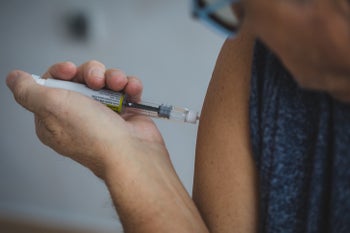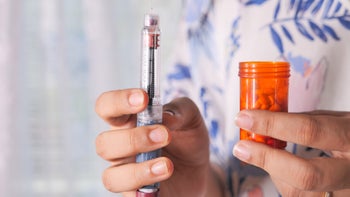
Toujeo
Toujeo SoloStar and Toujeo Max SoloStar are a pair of brand names for insulin glargine. This medication is a long-acting insulin that's used for diabetes in adults and children. It's a more concentrated version of insulin glargine containing 300 units/mL. It comes as prefilled pens that you use for once-daily injections under the skin. Side effects include common cold symptoms and low blood sugar.

What is Toujeo (insulin glargine)?
What is Toujeo (insulin glargine) used for?
How Toujeo (insulin glargine) works
Toujeo (insulin glargine) is an insulin, which is a hormone your body normally makes to lower glucose (sugar) levels in the blood. It helps your body absorb sugar from your bloodstream and store it for energy. Insulins also stop your liver from making glucose.
Drug Facts
More on Toujeo (insulin glargine) essentials

Get your GoodRx coupon

What are the side effects of Toujeo (insulin glargine)?
Common Side Effects
- Low blood sugar
- Common cold symptoms
- Infection involving the nose, throat, and lungs
Other Side Effects
- Fluid buildup
- Weight gain
- Injection site reactions (such as pain, swelling, redness)
Serious Side Effects
- Severely low blood sugar: feeling shaky, nervous or anxious; fast heartbeat; sweating; body chills; confusion; feeling sleepy; weakness or low energy, excessive hunger
- Severely low potassium levels: weakness, muscle cramps or twitches, constipation, irregular heartbeat
- Severe allergic reaction: rash; hives; swelling of face, tongue, and throat; trouble breathing
Source: DailyMed
More on Toujeo (insulin glargine) side effects
The following side effects have also been reported
Side effects that you should report to your care team as soon as possible:
- Allergic reactions—skin rash, itching, hives, swelling of the face, lips, tongue, or throat
- Low blood sugar (hypoglycemia)—tremors or shaking, anxiety, sweating, cold or clammy skin, confusion, dizziness, rapid heartbeat
- Low potassium level—muscle pain or cramps, unusual weakness or fatigue, fast or irregular heartbeat, constipation
Side effects that usually do not require medical attention (report these to your care team if they continue or are bothersome):
- Lipodystrophy—hardening or scarring of tissue at injection site
- Pain, redness, or irritation at injection site
- Weight gain

Pros and cons of Toujeo (insulin glargine)

Pros
Long-lasting insulin that provides consistent, all-day blood sugar control
Given once a day
Available as a prefilled pen
Good choice for people who need high doses of long-acting insulin
Can use in children as young as 6 years old

Cons
Must inject the medication under the skin
Might be difficult for some people to administer correctly
Can cause weight gain and low blood sugar (hypoglycemia)
Can't be mixed with other insulins

Pharmacist tips for Toujeo (insulin glargine)

Store unopened Toujeo (insulin glargine) pens in the refrigerator until the expiration date. Keep opened pens at room temperature for up to 56 days; don't put them in the refrigerator.
Typically, you should still take Toujeo (insulin glargine) even if you haven't eaten all day. This type of insulin is used to maintain your "baseline" blood sugar rather than to regulate your blood sugar from food. Since everyone's insulin needs are different, ask your prescriber about when you should and shouldn't use Toujeo (insulin glargine).
Check your blood sugar right away if you have symptoms of low blood sugar, such as shakiness, sweating, fast and irregular heartbeat, or feeling faint.
Be sure you and your loved ones know how to treat low blood sugar if your blood sugar levels are between 50 mg/dL and 70 mg/dL. Follow the "15-15" rule: eat 15 grams of fast-acting sugar (e.g., a few glucose tablets, one-half cup of fruit juice) to try to bring your blood sugar back up, wait 15 minutes, and recheck your blood sugar. Call 911 and repeat these steps if it's still below 70 mg/dL or if you still have symptoms of low blood sugar.
Don't mix Toujeo (insulin glargine) with other insulins within the same syringe. If you're prescribed a different type of insulin (e.g., short-acting insulin) to use in addition to Toujeo (insulin glargine), you must use two separate pens or syringes for each insulin.
How to inject Toujeo (insulin glargine):
Your care team will give you training on how to administer Toujeo (insulin glargine). Make sure you know how to use the medication to avoid accidentally hurting yourself or wasting the medication. Carefully read the Instructions for Use. Contact your care team if you have any questions.
Before you inject Toujeo (insulin glargine), check that the insulin in the pen is clear and colorless without any particles (solid chunks). If it isn't, don't use the pen and ask your pharmacist for a replacement.
Inject Toujeo (insulin glargine) under the skin (subcutaneously). You can inject the medication into the skin of your stomach area (2 inches away from your belly button), thighs, or back of your upper arms.
Be sure to rotate injection sites to prevent hard lumps from forming in your skin. Avoid injecting into skin that has pits, is thickened, or has lumps. Also, avoid injecting into skin that's tender, bruised, scaly, hard, scarred, or damaged to prevent more irritation.
Always use a new needle for each injection to help prevent infections and blocked needles. Don't reuse or share your needles with other people to avoid spreading infections.
Throw away all used needles and empty Toujeo (insulin glargine) pens in a sharps container or something made of heavy-duty plastic, such as an empty milk carton or laundry detergent bottle. This helps lower the risk of needle-stick injuries. Don't throw away needles and pens in your trash can.
More on Toujeo (insulin glargine) tips

Frequently asked questions about Toujeo (insulin glargine)

How to save using GoodRx




What are the risks and warnings for Toujeo (insulin glargine)?
Toujeo (insulin glargine) can cause some serious health issues. This risk may be even higher for certain groups. If this worries you, talk to your doctor or pharmacist about other options.

Risk of infections with pen sharing
Never share Toujeo (insulin glargine) pens, syringes, or needles with anyone else. Sharing Toujeo (insulin glargine) puts you and the person who's also using the same pen at risk of getting very dangerous infections and health conditions.

Low blood sugar (hypoglycemia)
Risk factors: Changes in diet and exercise | Drinking alcohol | Taking other medications for diabetes together with Toujeo (insulin glargine) | Liver or kidney problems | Not using Toujeo (insulin glargine) correctly
Toujeo (insulin glargine), alone or together with other diabetes medications, can cause low blood sugar. It can be life-threatening if your blood sugar drops too much. To prevent low blood sugar due to medication mix-ups, always check the medication labels of all your diabetes medications to make sure you're using the right one, especially if you're using multiple types of insulin.
Low blood sugar can happen suddenly and can look and feel differently for each person. Symptoms of low blood sugar can include feeling shaky, being nervous or anxious, fast heartbeat, sweating or body chills, confusion, feeling sleepy, weakness or low energy, or excessive hunger.
Make sure you know how to recognize and treat low blood sugar in case this happens. Carry some form of fast-acting sugar (e.g., glucose tablets, hard candy, fruit juice) at all times while you're taking this medication. They can come in handy to raise your blood sugar if it drops too much.

Low blood potassium levels
Risk factors: Taking other medications with Toujeo (insulin glargine) that lower potassium
Toujeo (insulin glargine) can lower the levels of potassium in your blood, which can be dangerous. You're more at risk if you're already taking medications that lower your potassium (e.g., certain diuretics or water pills). If needed, your prescriber might check your potassium levels regularly and give you medications to keep your potassium normal.
Symptoms of low potassium levels include weakness, muscle cramps or twitches, digestive problems, or abnormal heartbeats. Call a healthcare professional if you have these symptoms while you're taking this medication.

Swelling and heart failure when used with certain diabetes medications
Risk factors: Taking glitazones together with Toujeo (insulin glargine) | History of heart failure
Taking Toujeo (insulin glargine) with glitazones (also known as thiazolidinediones), like pioglitazone (Actos), can cause your body to hold onto fluid. This can lead to or worsen heart failure because the additional fluid can put stress on your heart and cause symptoms such as trouble breathing or the inability to exercise.
Make sure to tell your prescriber if you have heart failure or if you're taking a glitazone before you start Toujeo (insulin glargine). And contact your care team if you have unusual sudden weight gain, swelling, or trouble breathing because these can be signs of fluid buildup and heart failure.

Allergic reactions
Rarely, Toujeo (insulin glargine) can cause a serious, life-threatening allergic reaction (e.g., anaphylaxis). Get medical help right away if you experience swelling in your lips, face, or tongue; rash; or trouble breathing.

Toujeo (insulin glargine) dosage forms
Typical dosing for Toujeo (insulin glargine)
Your prescriber will work with you to find the dose that works best for you. Your dose depends on many things, such as whether you have Type 1 or Type 2 diabetes, your blood sugar levels, and your weight.
Toujeo (insulin glargine) is injected under the skin in the stomach, thigh, or upper arm once per day.
Type 1 diabetes and first time using insulin: Your prescriber will calculate your total daily insulin (TDI) requirement. The typical starting dose is about a third to a half of your TDI requirement, injected under the skin once per day.
Type 2 diabetes and first time using insulin: Your prescriber will calculate your dose based on your body weight. The typical starting dose is 0.2 units/kg (up to 10 units) injected under the skin once per day.

How much does Toujeo (insulin glargine) cost?

Toujeo (insulin glargine) contraindications

What are alternatives to Toujeo (insulin glargine)?

What is the latest news about Toujeo (insulin glargine)?

Toujeo (insulin glargine) images
Get savings updates for Toujeo (insulin glargine)
Receive price alerts, news, and other messages from GoodRx about Toujeo (insulin glargine) and other healthcare topics and relevant savings offers.By providing your email, you consent to receive marketing communications from GoodRx, which may include content and/or data related to men’s health, women's health, reproductive care, or sexual health. You agree to the GoodRx Terms of Use and acknowledge the Privacy Policy. You can unsubscribe at any time.
References
Best studies we foundAmerican Diabetes Association. (2012). Hypoglycemia? Low blood glucose? Low blood sugar? Clinical Diabetes.
American Diabetes Association. (n.d.). Understanding and managing low blood glucose (hypoglycemia).
Krische, D. (2000). The glitazones: Proceed with caution. The Western Journal of Medicine.
Lau, I. T., et al. (2017). Insulin glargine 300 U/mL for basal insulin therapy in type 1 and type 2 diabetes mellitus. Diabetes, Metabolic Syndrome and Obesity.
Lewis, J. L. 3rd. (2023). Hypokalemia (low level of potassium in the blood). Merck Manual Consumer Version.
Sanofi-Aventis U.S. LLC. (2023). Toujeo- insulin glargine injection, solution; Toujeo Max - insulin glargine injection, solution [package insert]. DailyMed.
Sanofi-Aventis US LLC. (2023). Your injection guide for getting started | Toujeo Max SoloStar®.
You and Your Hormones. (2021). Insulin.
Compare other Diabetes Type 2, Diabetes Type 1 drugs
Browse medications
View AllResearch prescriptions and over-the-counter medications from A to Z, compare drug prices, and start saving.


















